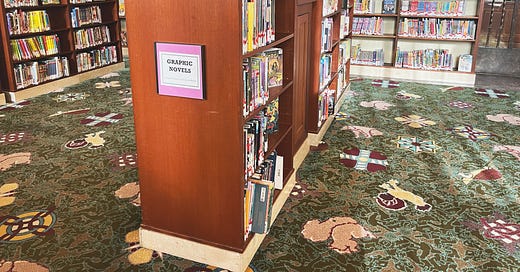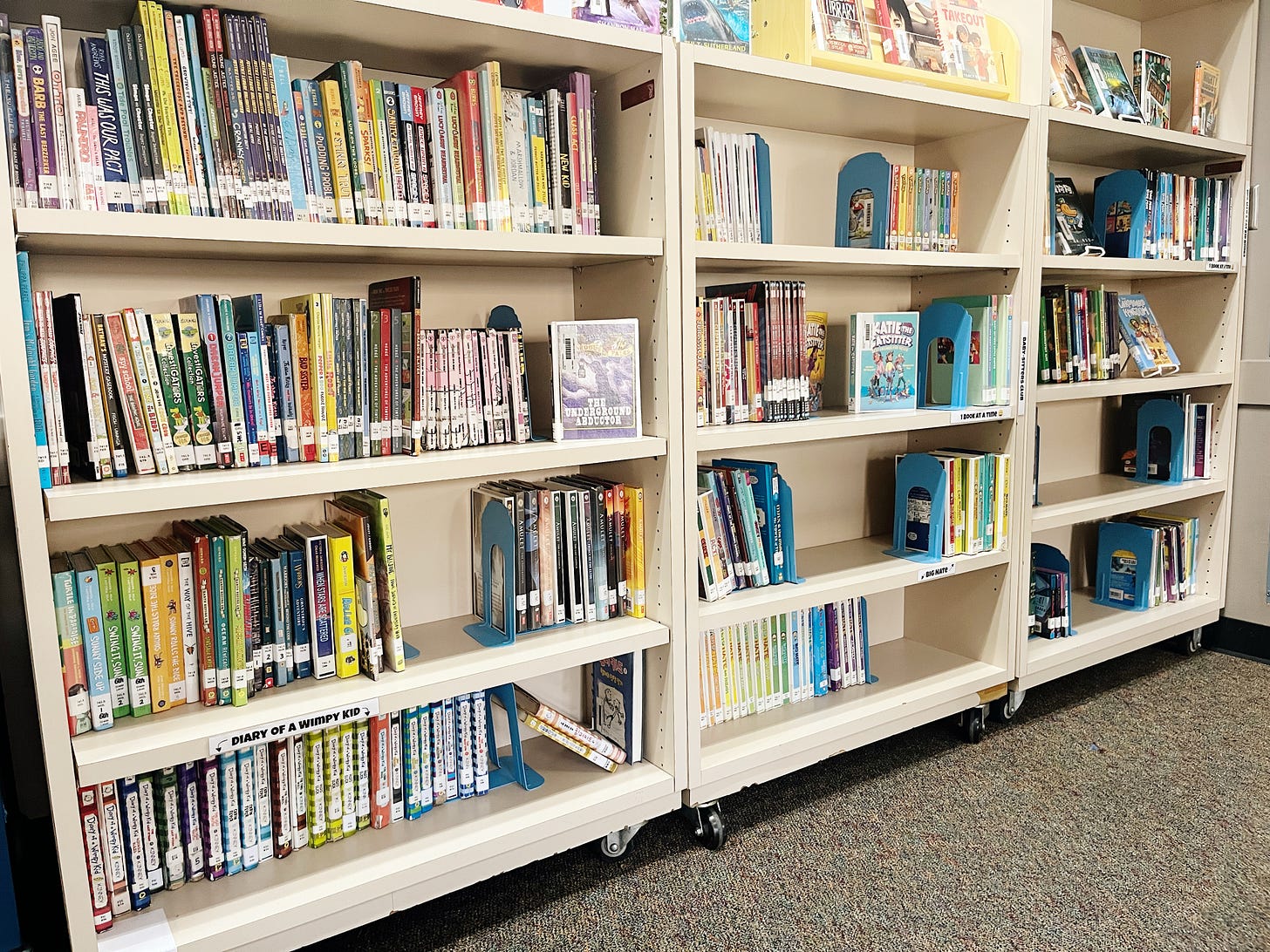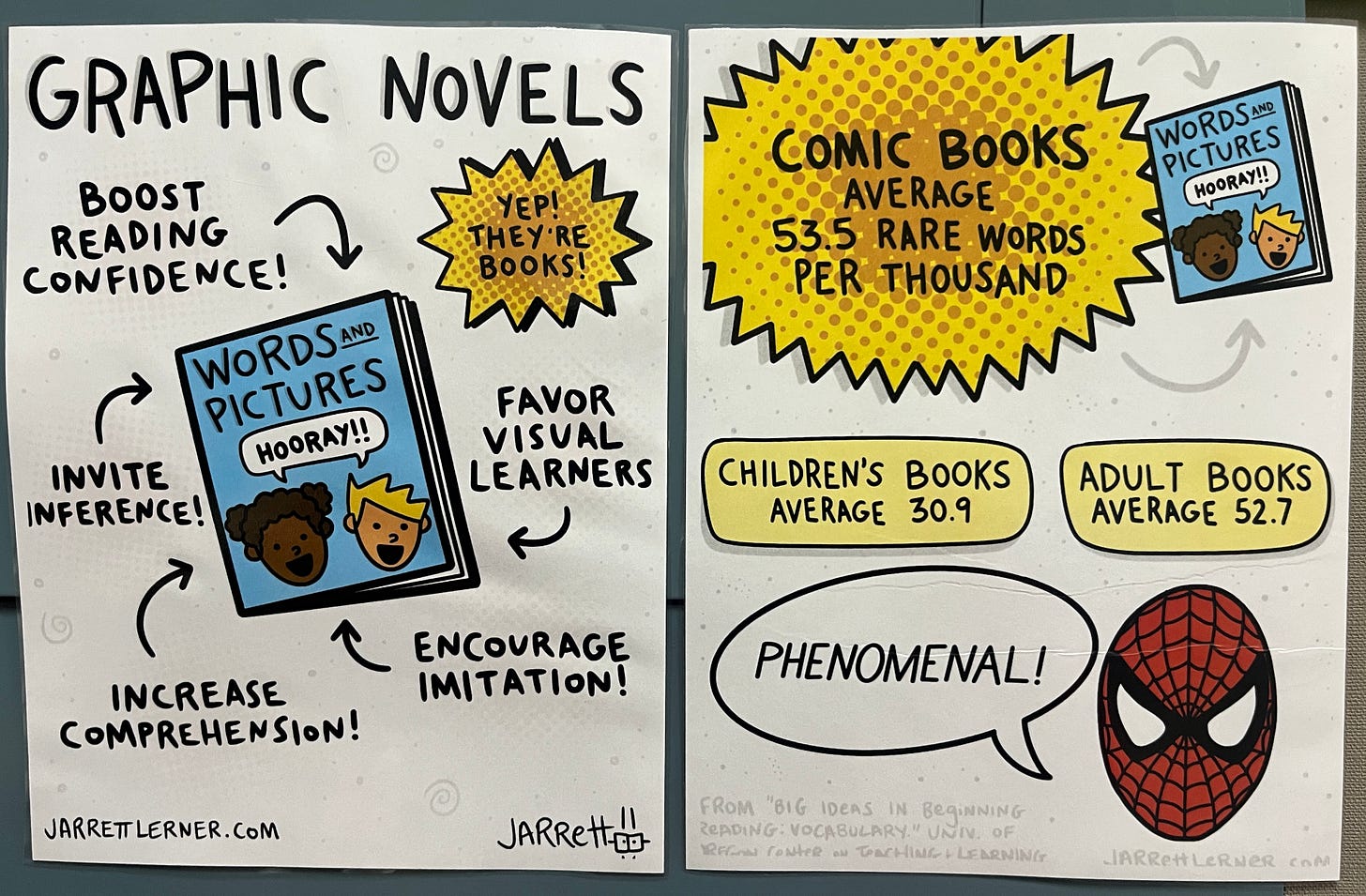By and large, the most popular books in our library are graphic novels & comics. This is unsurprising because according to recent School Library Journal (source linked at bottom of page1) research, "the format's popularity has shot up at over 90 percent of school libraries" in the last few years. I was so excited to see the linked SLJ article grace the cover of October issue, because a couple of years ago when I was taking library technology classes I had hard time finding recent research and discussion about graphic novels and literacy. Graphic novels can no longer be ignored though as is proven by their boom in the publishing market and in my own school school library (and to be honest, in my own home!).
The most popular books at our school are consistent with the schools surveyed by SLJ. The market and my own experience are clear: graphic novels are getting our kids into libraries and bookstores and reading. And believe it or not, these books can greatly impact literacy and a love of reading in our students!
It's easy for some people to cast off comics and graphic novels as unworthy literature, but I think this is shortsighted. In my experience, graphic novels are extremely beneficial in getting students excited about reading and creating a lasting love of reading in kids.
One public librarian commented, "For many children, graphic novels start their love of reading, because words are broken down into smaller spaces with lots of pictures" (SLJ), and I would agree with that. I have personally seen students (including my own kids) who love graphic novels eventually make the jump to also enjoying narrative fiction.
Graphic novels are accessible and easy to read, interesting and dynamic because of the comic illustrations, and can be binge-read at a faster pace than novels. In our library, the students who check out graphic novels regularly are often coming into the library on their own and checking out more books outside of their class time.
Many graphic novels also tackle big themes and topics but in a less heavy-handed or intimidating way than some novels. Since graphic novels are so visual, we really get to see how a character's emotions play out and we get to read facial expressions and learn to "read between the lines" in stories.
I think due to the popularity of graphic novels in the publishing market that we will see even more research in the coming years about how these books impact literacy (and I look forward to it!). One study2 done on graphic novel reading with 5th graders in the last ten years reports:
“The survey results showed that the students reading graphic novels reported greater enjoyment of reading and stronger interest in the story than when reading either of the other two novel forms. These differences were associated with large effect sizes when ratings of graphic novels were compared to traditional novels and medium effect sizes when compared to heavily-illustrated novels. These differences in student perceptions show the power of graphic novels to motivate and engage students.”
I have this poster below, drawn by artist/author Jarrett Lerner, hanging near our graphic novels as a reminder of their value. In it he references3 the concept of rare words and how many more of these exist in comic books.
Another important benefit to reading graphic novels and comics is their effect on visual literacy. Penn State University Libraries4 defines this term: "Visual literacy for graphic novels/comics is the ability to simultaneously interpret, analyze, and make meaningful, significant, relevant both the images and written texts of this medium, and uses this amalgamation to create deeper, more complex, more exploratory, more comprehensive understandings of the themes expressed in these works." As our students grow up in an increasingly-visual culture, visual literacy is vital to them.

In our library, we have a section of shelves dedicated to graphic novels (pictured at the top of this post), and this is the most popular section of the library. Interestingly, I noticed that at my local San Diego County Library branch, the graphic novels are now also shelved separately from the rest of juvenile fiction for easy access (a recent and welcome change). At the Los Angeles Public Library Central Branch, I spoke to a children’s librarian who said they have long kept their graphics on separate shelves. And in, fact, they are the first shelves patrons come to upon entering the children’s literature room.
One of the most striking details from both our top circulated titles and also any browsing of available graphic novels in the market is that they cover a variety and diverse selection of topics, genres, and character types. Whether a kid is into dragons, friendship drama, or slapstick humor, there seems to now be a graphic novel suited to every reader. More and more classics and popular novels are being adapted into graphic novels too, which is enticing students who wouldn't otherwise pick up those books to try them out in a more accessible form (first). Graphic novels are also great for English learners as the detailed illustrations can help them decode the story. (We also now have a few Dog Man and Wimpy Kid books in Korean and Chinese in my library!)
Often, when I see which graphic novels a student is devouring, I am able to then recommend them chapter books/novels that will align with their interests and help them make the jump to trying something they would otherwise shy away from. And if they fall in love with a graphic adaptation, it is only natural for them to then try out the original novel to get more from a beloved story or series.
For me what it ultimately comes down to is the joy of reading and seeing a child delight in a book is something special to behold. If graphic novels are effective in bringing kids joy and delight in a book, I’m all for it.
Eventually kids will outgrow books like Dog Man and Diary of a Wimpy Kid, but my hope is that by then, the love of the act of cracking open and reading an entertaining book will be cemented in them. And if they find a graphic novel series that speaks to them, I can only imagine that the excitement of waiting for that next installment to be published will be ingrained in them and translate to other kinds of series reading as well in the future.
Cockcroft, Marlaina. "Graphic novels and manga explode in popularity among students." School Library Journal, October 2023. https://www.slj.com/story/Graphic-Novels-Manga-Explode-in-Popularity-Among-Students-SLJ-Survey
Jennings, K. A., Rule, A. C., & Vander Zanden, S. M. (2014). Fifth Graders' Enjoyment, Interest, and Comprehension of Graphic Novels Compared to Heavily-Illustrated and Traditional Novels. International Electronic Journal of Elementary Education, 6(2), 257-274. https://login.ezproxy.palomar.edu/login?url=https://search-ebscohost-com.ezproxy.palomar.edu/login.aspx?direct=true&db=eric&AN=EJ1053749&site=ehost-live&scope=site
National Center on Improving Literacy (2023). The 5 Big Ideas of Beginning Reading. Washington, DC: U.S. Department of Education, Office of Elementary and Secondary Education, Office of Special Education Programs, National Center on Improving Literacy. Retrieved from https://improvingliteracy.org/brief/5-big-ideas-beginning-reading
Comics and Animation Library Guide. Penn State University Library, January 2023. https://guides.libraries.psu.edu/comics_animation







Totally agree! Reading what you love begets a love for reading. Early graphic novels like 'Babymouse' got my kids hooked on independent reading, begging to go to the library, and now they happily devour all kinds of novels- graphic and otherwise. They've outgrown the early GNs, but those are my favorite so I still read a few of those per week. 😁